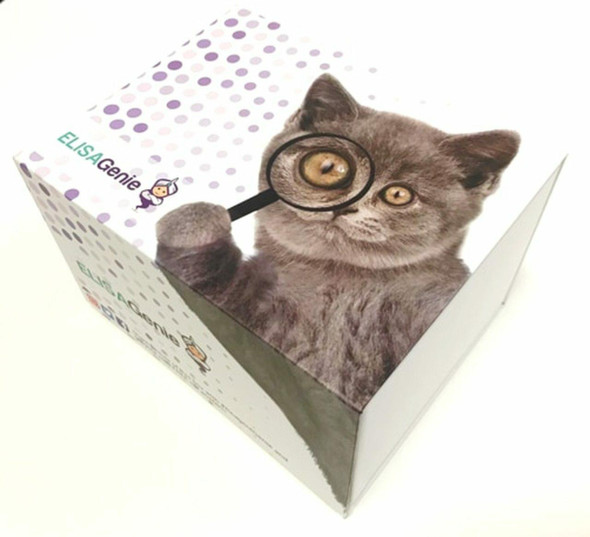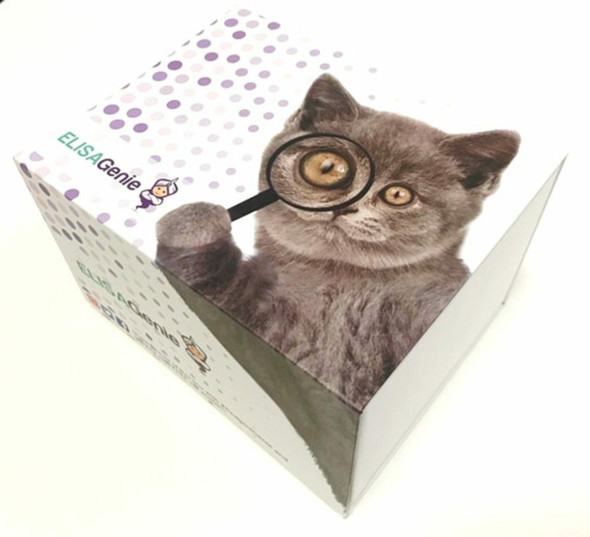Description
Human Prostaglandin G/H synthase 1 (PTGS1) ELISA Kit
The Human Prostaglandin G/H Synthase 1 (PTGS1) ELISA Kit is specifically designed for the precise measurement of PTGS1 levels in human serum, plasma, and cell culture supernatants. With its exceptional sensitivity and specificity, this kit ensures accurate and consistent results, making it an indispensable tool for various research applications.PTGS1, also known as cyclooxygenase-1 (COX-1), is a key enzyme involved in the production of prostaglandins, which play critical roles in inflammation, immune response, and various physiological processes.
Dysregulation of PTGS1 has been linked to inflammatory diseases, cardiovascular disorders, and cancer, highlighting its importance as a potential therapeutic target and biomarker.By providing a reliable and efficient method for quantifying PTGS1 levels, the Human PTGS1 ELISA Kit enables researchers to investigate the role of this enzyme in disease pathogenesis, drug development, and personalized medicine. Take your research to the next level with this cutting-edge ELISA kit from AssayGenie.
| Product Name: | Human Prostaglandin G/H synthase 1 (PTGS1) ELISA Kit |
| SKU: | HUEB0433 |
| Size: | 96T |
| Target: | Human Prostaglandin G/H synthase 1 (PTGS1) |
| Synonyms: | Cyclooxygenase-1, Prostaglandin H2 synthase 1, Prostaglandin-endoperoxide synthase 1, COX-1, PGH synthase 1, COX1 |
| Assay Type: | Sandwich |
| Detection Method: | ELISA |
| Reactivity: | Human |
| Detection Range: | 0.312-20ng/mL |
| Sensitivity: | 0.11ng/mL |
| Intra CV: | 5.1% | ||||||||||||||||||||
| Inter CV: | 9.6% | ||||||||||||||||||||
| Linearity: |
| ||||||||||||||||||||
| Recovery: |
| ||||||||||||||||||||
| Function: | Converts arachidonate to prostaglandin H2 (PGH2), a committed step in prostanoid synthesis. Involved in the constitutive production of prostanoids in particular in the stomach and platelets. In gastric epithelial cells, it is a key step in the generation of prostaglandins, such as prostaglandin E2 (PGE2), which plays an important role in cytoprotection. In platelets, it is involved in the generation of thromboxane A2 (TXA2), which promotes platelet activation and aggregation, vasoconstriction and proliferation of vascular smooth muscle cells. |
| Uniprot: | P23219 |
| Sample Type: | Serum, plasma, tissue homogenates, cell culture supernates and other biological fluids |
| Specificity: | Natural and recombinant human Prostaglandin G/H synthase 1 |
| Sub Unit: | Homodimer. |
| Research Area: | Cardiovascular |
| Subcellular Location: | Microsome membrane Peripheral membrane protein Endoplasmic reticulum membrane Peripheral membrane protein |
| Storage: | Please see kit components below for exact storage details |
| Note: | For research use only |
| UniProt Protein Function: | COX-1: May play an important role in regulating or promoting cell proliferation in some normal and neoplastically transformed cells. Homodimer. Belongs to the prostaglandin G/H synthase family. 2 isoforms of the human protein are produced by alternative splicing. |
| UniProt Protein Details: | Protein type:EC 1.14.99.1; Lipid Metabolism - arachidonic acid; Oxidoreductase Chromosomal Location of Human Ortholog: 9q32-q33.3 Cellular Component: endoplasmic reticulum membrane; photoreceptor outer segment; intracellular membrane-bound organelle; cytoplasm; nucleus Molecular Function:prostaglandin-endoperoxide synthase activity; peroxidase activity; dioxygenase activity; metal ion binding; heme binding Biological Process: regulation of blood pressure; xenobiotic metabolic process; cyclooxygenase pathway; arachidonic acid metabolic process; response to oxidative stress; lipid metabolic process; prostaglandin biosynthetic process; inflammatory response; regulation of cell proliferation |
| NCBI Summary: | This is one of two genes encoding similar enzymes that catalyze the conversion of arachinodate to prostaglandin. The encoded protein regulates angiogenesis in endothelial cells, and is inhibited by nonsteroidal anti-inflammatory drugs such as aspirin. Based on its ability to function as both a cyclooxygenase and as a peroxidase, the encoded protein has been identified as a moonlighting protein. The protein may promote cell proliferation during tumor progression. Alternative splicing results in multiple transcript variants. [provided by RefSeq, Jan 2014] |
| UniProt Code: | P23219 |
| NCBI GenInfo Identifier: | 317373262 |
| NCBI Gene ID: | 5742 |
| NCBI Accession: | P23219.2 |
| UniProt Secondary Accession: | P23219,Q15122, Q3HY28, Q3HY29, Q5T7T6, Q5T7T7, Q5T7T8 A8K1V7, B4DHQ2, B4E2S5, |
| UniProt Related Accession: | P23219 |
| Molecular Weight: | 72,010 Da |
| NCBI Full Name: | Prostaglandin G/H synthase 1 |
| NCBI Synonym Full Names: | prostaglandin-endoperoxide synthase 1 (prostaglandin G/H synthase and cyclooxygenase) |
| NCBI Official Symbol: | PTGS1 |
| NCBI Official Synonym Symbols: | COX1; COX3; PHS1; PCOX1; PES-1; PGHS1; PTGHS; PGG/HS; PGHS-1 |
| NCBI Protein Information: | prostaglandin G/H synthase 1; PGH synthase 1; cyclooxygenase-1; prostaglandin H2 synthase 1 |
| UniProt Protein Name: | Prostaglandin G/H synthase 1 |
| UniProt Synonym Protein Names: | Cyclooxygenase-1; COX-1; Prostaglandin H2 synthase 1; PGH synthase 1; PGHS-1; PHS 1; Prostaglandin-endoperoxide synthase 1 |
| Protein Family: | Cox1 intron-like protein |
| UniProt Gene Name: | PTGS1 |
| UniProt Entry Name: | PGH1_HUMAN |
| Component | Quantity (96 Assays) | Storage |
| ELISA Microplate (Dismountable) | 8×12 strips | -20°C |
| Lyophilized Standard | 2 | -20°C |
| Sample Diluent | 20ml | -20°C |
| Assay Diluent A | 10mL | -20°C |
| Assay Diluent B | 10mL | -20°C |
| Detection Reagent A | 120µL | -20°C |
| Detection Reagent B | 120µL | -20°C |
| Wash Buffer | 30mL | 4°C |
| Substrate | 10mL | 4°C |
| Stop Solution | 10mL | 4°C |
| Plate Sealer | 5 | - |
Other materials and equipment required:
- Microplate reader with 450 nm wavelength filter
- Multichannel Pipette, Pipette, microcentrifuge tubes and disposable pipette tips
- Incubator
- Deionized or distilled water
- Absorbent paper
- Buffer resevoir
*Note: The below protocol is a sample protocol. Protocols are specific to each batch/lot. For the correct instructions please follow the protocol included in your kit.
Allow all reagents to reach room temperature (Please do not dissolve the reagents at 37°C directly). All the reagents should be mixed thoroughly by gently swirling before pipetting. Avoid foaming. Keep appropriate numbers of strips for 1 experiment and remove extra strips from microtiter plate. Removed strips should be resealed and stored at -20°C until the kits expiry date. Prepare all reagents, working standards and samples as directed in the previous sections. Please predict the concentration before assaying. If values for these are not within the range of the standard curve, users must determine the optimal sample dilutions for their experiments. We recommend running all samples in duplicate.
| Step | |
| 1. | Add Sample: Add 100µL of Standard, Blank, or Sample per well. The blank well is added with Sample diluent. Solutions are added to the bottom of micro ELISA plate well, avoid inside wall touching and foaming as possible. Mix it gently. Cover the plate with sealer we provided. Incubate for 120 minutes at 37°C. |
| 2. | Remove the liquid from each well, don't wash. Add 100µL of Detection Reagent A working solution to each well. Cover with the Plate sealer. Gently tap the plate to ensure thorough mixing. Incubate for 1 hour at 37°C. Note: if Detection Reagent A appears cloudy warm to room temperature until solution is uniform. |
| 3. | Aspirate each well and wash, repeating the process three times. Wash by filling each well with Wash Buffer (approximately 400µL) (a squirt bottle, multi-channel pipette,manifold dispenser or automated washer are needed). Complete removal of liquid at each step is essential. After the last wash, completely remove remaining Wash Buffer by aspirating or decanting. Invert the plate and pat it against thick clean absorbent paper. |
| 4. | Add 100µL of Detection Reagent B working solution to each well. Cover with the Plate sealer. Incubate for 60 minutes at 37°C. |
| 5. | Repeat the wash process for five times as conducted in step 3. |
| 6. | Add 90µL of Substrate Solution to each well. Cover with a new Plate sealer and incubate for 10-20 minutes at 37°C. Protect the plate from light. The reaction time can be shortened or extended according to the actual color change, but this should not exceed more than 30 minutes. When apparent gradient appears in standard wells, user should terminatethe reaction. |
| 7. | Add 50µL of Stop Solution to each well. If color change does not appear uniform, gently tap the plate to ensure thorough mixing. |
| 8. | Determine the optical density (OD value) of each well at once, using a micro-plate reader set to 450 nm. User should open the micro-plate reader in advance, preheat the instrument, and set the testing parameters. |
| 9. | After experiment, store all reagents according to the specified storage temperature respectively until their expiry. |
When carrying out an ELISA assay it is important to prepare your samples in order to achieve the best possible results. Below we have a list of procedures for the preparation of samples for different sample types.
| Sample Type | Protocol |
| Serum | If using serum separator tubes, allow samples to clot for 30 minutes at room temperature. Centrifuge for 10 minutes at 1,000x g. Collect the serum fraction and assay promptly or aliquot and store the samples at -80°C. Avoid multiple freeze-thaw cycles. If serum separator tubes are not being used, allow samples to clot overnight at 2-8°C. Centrifuge for 10 minutes at 1,000x g. Remove serum and assay promptly or aliquot and store the samples at -80°C. Avoid multiple freeze-thaw cycles. |
| Plasma | Collect plasma using EDTA or heparin as an anticoagulant. Centrifuge samples at 4°C for 15 mins at 1000 × g within 30 mins of collection. Collect the plasma fraction and assay promptly or aliquot and store the samples at -80°C. Avoid multiple freeze-thaw cycles. Note: Over haemolysed samples are not suitable for use with this kit. |
| Urine & Cerebrospinal Fluid | Collect the urine (mid-stream) in a sterile container, centrifuge for 20 mins at 2000-3000 rpm. Remove supernatant and assay immediately. If any precipitation is detected, repeat the centrifugation step. A similar protocol can be used for cerebrospinal fluid. |
| Cell culture supernatant | Collect the cell culture media by pipette, followed by centrifugation at 4°C for 20 mins at 1500 rpm. Collect the clear supernatant and assay immediately. |
| Cell lysates | Solubilize cells in lysis buffer and allow to sit on ice for 30 minutes. Centrifuge tubes at 14,000 x g for 5 minutes to remove insoluble material. Aliquot the supernatant into a new tube and discard the remaining whole cell extract. Quantify total protein concentration using a total protein assay. Assay immediately or aliquot and store at ≤ -20 °C. |
| Tissue homogenates | The preparation of tissue homogenates will vary depending upon tissue type. Rinse tissue with 1X PBS to remove excess blood & homogenize in 20ml of 1X PBS (including protease inhibitors) and store overnight at ≤ -20°C. Two freeze-thaw cycles are required to break the cell membranes. To further disrupt the cell membranes you can sonicate the samples. Centrifuge homogenates for 5 mins at 5000xg. Remove the supernatant and assay immediately or aliquot and store at -20°C or -80°C. |
| Tissue lysates | Rinse tissue with PBS, cut into 1-2 mm pieces, and homogenize with a tissue homogenizer in PBS. Add an equal volume of RIPA buffer containing protease inhibitors and lyse tissues at room temperature for 30 minutes with gentle agitation. Centrifuge to remove debris. Quantify total protein concentration using a total protein assay. Assay immediately or aliquot and store at ≤ -20 °C. |
| Breast Milk | Collect milk samples and centrifuge at 10,000 x g for 60 min at 4°C. Aliquot the supernatant and assay. For long term use, store samples at -80°C. Minimize freeze/thaw cycles. |










